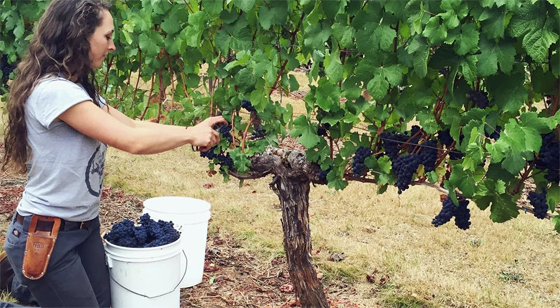Explore Oregon Wines: Wineries | Varietals | AVAs | Cellar 503 Selections

EST Wines 2018 Rosé Swirl
A maverick that’s stealing the show
For Meredith Bell, spending two years “in an Islamic republic where wine is illegal” while serving in the Peace Corps convinced her that wine would be her future. Shortly after, the biochemistry graduate found her way to an Umpqua Valley winery, River’s Edge.
Before long, she was in Burgundy to learn about Pinot Noir. “But I was like holy shit, the Chardonnay stole the show for me every time,” Bell says. “I kept making trips up to Chablis, so while I thought I was supposed to there for the red wine, it turns out I wasn’t.”
Meredith’s approach? Question all the assumptions. Study the masters deeply, then challenge everything they’re doing. She’s a UC Davis enology graduate, but part of a group heralded as “mavericks” who are “upending expectations” while “having fun in a way that’s unusual” in winemaking.
Last year, we featured a wine from Statera Cellars, a collaboration between Meredith and a fellow winemaker. But EST Wines is where Meredith runs the show herself, including personally managing a small four-acre vineyard just outside of Oregon City. The vineyard, planted in 1982, is proof that world class wines can be produced from the East side of the Willamette Valley – hence the name, EST.

Cellar 503 Tasting Notes
EST Wines, Portland, Oregon
2018 Rosé Swirl
Traditionally, in the saignée method, rosé wines are produced by carefully siphoning the lightest juice off the top of a tank of red wine as the solids settle. Alternately, winemakers can make rosé by leaving the red juice on the grape skins for a very short time (just hours) before pressing it off, reducing the color and tannin impact of the grape skins.
You want to discover experimental winemakers taking radical approaches? Meredith Bell has tried an approach that I’ve never seen before. I’m not sure anyone has.
For her Rosé Swirl, Meredith fermented Pinot Noir juice atop fresh whole Sauvignon Blanc grapes and pressed skins of Sauvignon Blanc grapes. That gives the wine the light tannins and texture of the Sauvignon Blanc alongside the Pinot Noir flavors.
It has the traditional earthy, forest floor components that you find with Pinot Noir balanced out by the fruity floral notes from the Sauvignon Blanc. You can almost feel the forest of giant trees that surround the vineyard. This is one of those wines that you just want to sit back and sip marveling in the unique flavors.
A Cellar 503 selection in May 2019, Women Winemakers Willamette Valley | Pinot Noir
